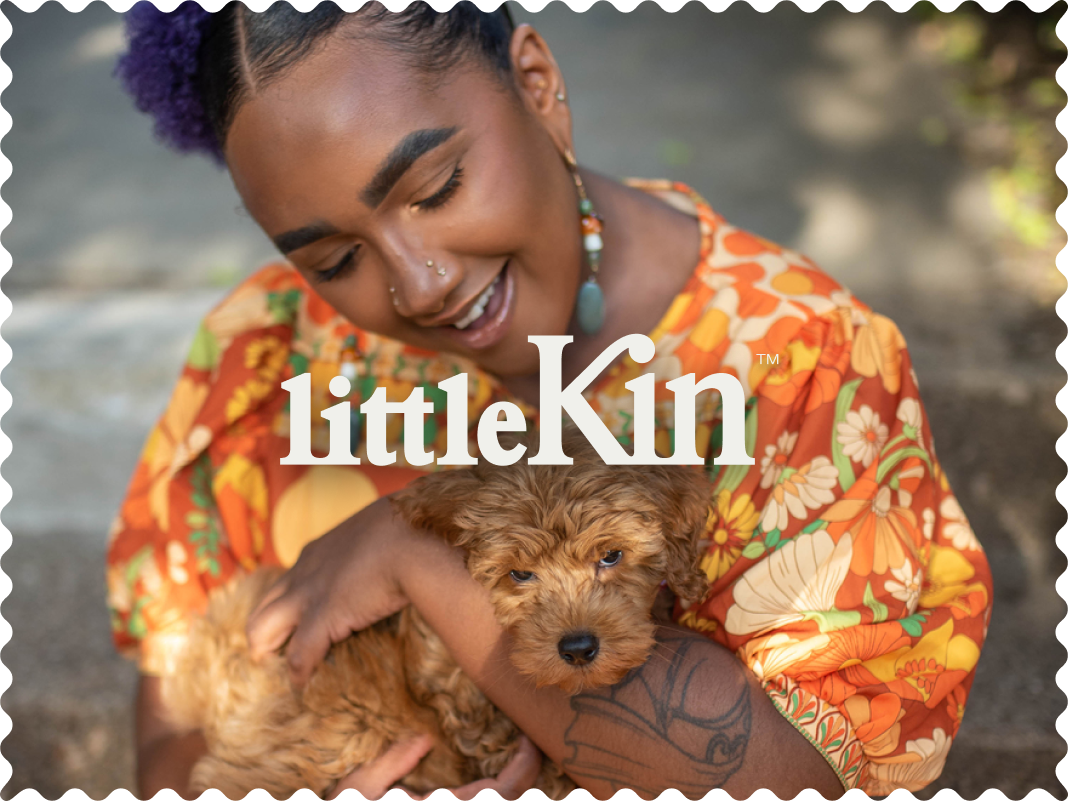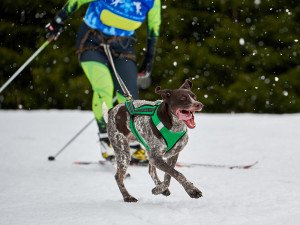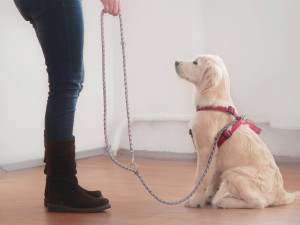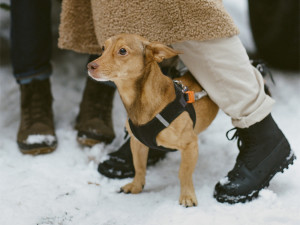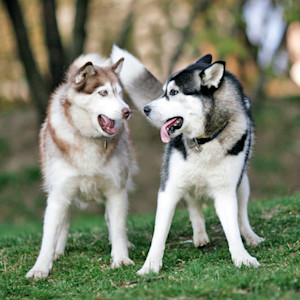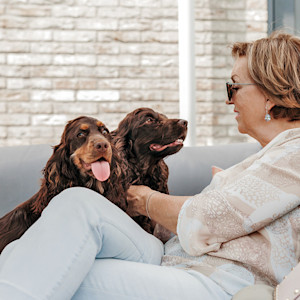Malamute vs Husky: Key Differences and Similarities, Explained
Both are excellent pups—just make sure you’re prepared to give them what they need.
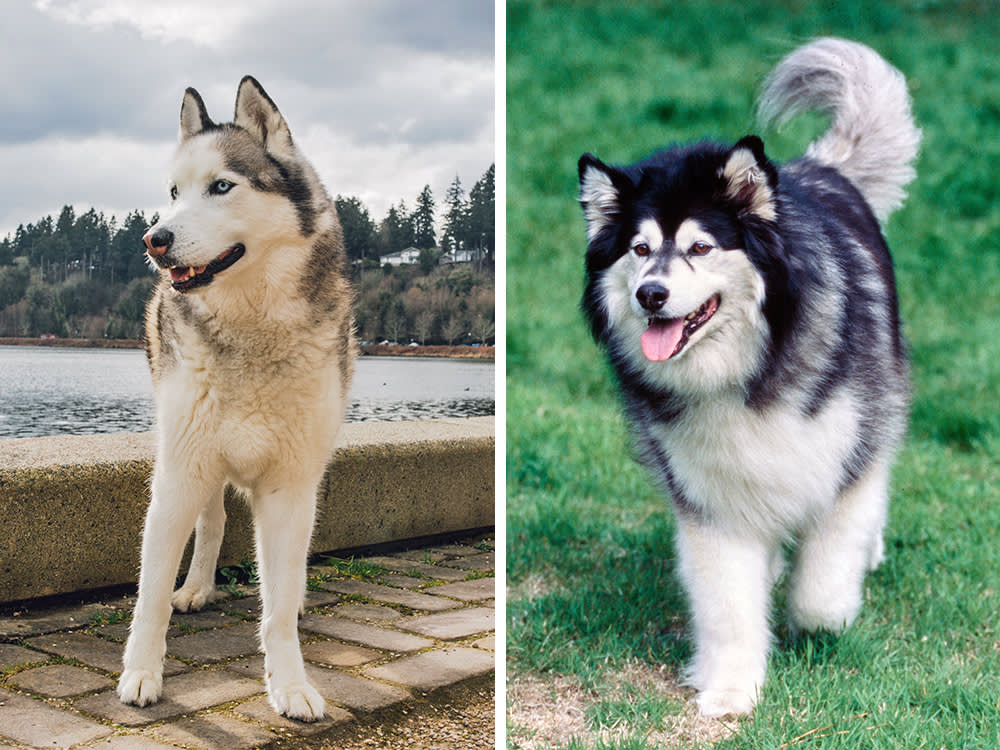
Share Article
In This Article:
Understanding the Malamute and Husky Breeds Main Differences Between the Two Breeds Main Similarities Between the Two Breeds Which Breed is the Best for You? Frequently Asked Questions
Alaskan Malamutes and Siberian Huskies have so many similarities that you may wonder why we are even discussing their differences. Although they are very much alike in their beautiful appearances, athleticism, and clever northern origins, they are suited for different lifestyles.
This guide will cover their similarities and differences so you can decide which one is best suited for you. You’ll also find some common care tips and a few FAQs.

Understanding the Malamute and Husky breeds
Historical background
Even though they were both bred for different jobs, the fact that both breeds are Arctic sled dogs still leads them to be energetic. That original purpose still drives their energy, affects their temperament, and guides their training needs today.
Alaskan Malamute
Of the two sled dogs, the Alaskan Malamute is the oldest, bred by the natives in Alaska. When you think of Malamutes, think of power and endurance more than speed, because their original job was hauling heavy freight over long distances. Today’s Malamute is still large, muscular, steady, and determined. Male Malamutes range from 75 to over 100 pounds, while females are smaller.
They come in several different coats, including various shades of gray and white, black and black, sable and white, or red and white. They have a hefty undercoat and a dense and plush coat. They usually have markings on their face and a plumed tail.
Despite their sometimes overbearing size, they are loyal and affectionate with their humans.
Siberian Husky
Originating from an entirely different region, northeastern Asia, the Siberian Husky evolved to pull light loads very quickly across long distances. They tend to be smaller and more agile than Malamutes. They often weigh 35 to 60 pounds.
Their double coat is medium-length, and they, too, come in many colors and patterns, often with gorgeous eyes in blue, brown, or bicolor.
Huskies are even more affectionate than Malamutes, very social, energetic, and mischievous. This affection often shows itself to strangers, meaning that while they are good companions, they are not natural guard dogs. They are also renowned escape artists and vocal “talkers.”
Main differences between Malamutes and Huskies
In summary, there are several differences between Malamutes and Huskies.
Size & build: Malamutes are much larger and heavier, bred for strength; Huskies are smaller and more aerodynamic, bred for speed.
Work style: Malamute offers power and endurance, while Huskies are known more for speed and endurance.
Temperament: Both breeds are affectionate and social, but have their differences. Malamutes are calmer inside if they’ve been exercised and act more independently. Huskies are known for being pranksters, more playful, and always on the move.
Dog-dog dynamics: Malamutes are more sex-selective and may not do well in multi-male or multi-female groups without strict management. Huskies, on the other hand, are usually quite social among all dogs, but not always, so pack management matters with both breeds.
Trainability profile: Both breeds are smart and independent. Huskies are famous for testing your patience by testing boundaries and being unreliable off-leash. Malamutes are often more focused on their handler.
Prey drive and escape risk: Both breeds are famous for both offenses, although Malamutes’ larger size can make acrobatics slightly less common.
Vocalization: Huskies are famous howlers and “talkers.” Malamutes can also be vocal but generally in a more subdued manner.
Grooming and coat: Both have heavy double coats and shed intensely
Health and lifespan: Huskies tend to live longer (about 12 to 14 years) while Malamutes survive about 10 to 12 years. Lifespan often trends a bit longer in Huskies (about 12 to 14 years) than Malamutes (about 10 to 12 years). Conditions that affect both include hip dysplasia, certain eye conditions (e.g., cataracts, PRA), and thyroid issues. Malamutes may also face polyneuropathy, while zinc-responsive skin issues are noted in Huskies.
Main similarities between Malamutes and Huskies
High need for daily, vigorous activity, plus mental stimulation.
Both thrive in cool climates, struggle in heat, and need careful warm-weather management.
Both are smart, resourceful, and can be stubborn.
They do best with consistent, rewards-based training.
Small pets and wildlife can trigger chase — don’t count on reliable recall; secure fencing and leash management are essential.
Expect heavy, seasonal shed-outs. Routine brushing and coat care are essential.
Both tend to be affectionate with family; neither is a natural guard do, despite intimidating looks.
Active, high-metabolism dogs require high-quality diets, appropriate caloric intake, and hydration — especially in hot weather.
Which breed is the best for you?
You’re the only person who can make that final decision, but we have tried to give you information and tips that will help you arrive at that conclusion. To recap:
Exercise and activity level
If you are interested in a companion that can accompany you at frequent, faster-paced outings, a Husky may be best for you. If you love endurance sports, daily runs, skijoring, bikejoring, or long hikes, either breed can thrive, but Huskies often especially excel at these activities.
On the other hand, if your desire is a powerful workout buddy with a steadier gait and who can enjoy activities like canicross or backpacking with weight, a Malamute may be your match.
If your schedule is inconsistent, neither breed is ideal. Both need high, predictable exercise and mental work —think puzzle feeders, scent games, carting, or rally sports.
Living space and environment
You also have to take into consideration the space you live in:
Apartment living: Possible for either breed, but more challenging for a Malamute. If you provide rigorous daily activity, it’s possible, but a Husky’s smaller size may be better in tight spaces. However, even a Husky still has high demands for daily exercise.
Yards and fencing: Six-foot (or higher) secure fencing is recommended for both. Huskies, especially, are talented at climbing or digging. Reinforce gates, consider dig guards, and supervise outdoor time.
Climate: Both breeds prefer cool weather. If it’s hot, keep their activity restricted to the cooler hours of the day and be sure to provide shade and water, avoid hot pavement, and use cooling mats or vests.
Family structure and social needs
Kids: Both breeds can coexist nicely with children. Huskies are known for their playfulness and may do better with active families. Due to the large size of Malamutes, they may need more supervision to prevent accidental knockdowns.
Both breeds can be good with children. Huskies’ playful nature often meshes well with active families. Malamutes’ size requires supervision around small kids to prevent accidental knockdowns.
Other dogs: Multi-dog homes can work with either breed, but introductions should be thoughtful. Malamutes may be less tolerant of same-sex competition; neutering or careful pairing can help.
Small pets: Due to the attraction of both breeds to small prey, it may be challenging to house small pets with either breed.
Alone time: Neither breed wants a lot of alone time. They need company, structure, and enrichment.
Additional tips to set either breed up for success
Training: Start early.
Mental work: Food puzzles, nose work, trick training, urban agility, and pulling sports burn brain energy.
Grooming: Both breeds will need weekly brushing (daily during shed season), occasional baths, and diligent undercoat raking during blow-out periods. Keep nails short; monitor ears and teeth.
Nutrition: Both breeds need a high-quality, complete diet; adjust calories according to body condition and activity level. Discuss joint supplements with your veterinarian.
Health screening: Ask if your vet can perform OFA hip and elbow exams, as well as eye exams. Also, inquire about thyroid and neurologic screenings.
Safety: ID tags, microchips, escape-proof gear (such as a well-fitted harness and martingale collar), and secure fencing are essential for these large, intelligent, high-metabolism pets.
Bottom line
These are two attractive, intelligent, talented breeds, but if you want a smaller, speedy endurance pal with a playful personality and the challenge of outsmarting an escape artist, you may want to go with a Siberian Husky.
If you’d prefer a large, strong companion with a steady personality and the ability for serious work, consider the Alaskan Malamute if you can manage the size, strength, and independence. Either way, expect daily exercise, mental enrichment, serious grooming, and consistent training. In return, you’ll get a loving, charismatic partner who brings Arctic spirit to your everyday life.
FAQs
Which breed requires more exercise and mental stimulation, a Malamute or a Husky?
Both require these characteristics, but Huskies usually require more frequent, fast-paced activity, and variety. Malamutes require the same but tend to calm down more indoors once their needs have been met.
Are Malamutes or Huskies better suited for families with children?
Both can be excellent with respectful, supervised children. Huskies tend to bring playful, goofy energy that many kids enjoy. Malamutes, being larger and stronger, require extra supervision around small children to prevent accidental knockdowns.
What are the grooming needs of a Malamute compared to a Husky?
Grooming demands are high for both. Expect heavy shedding year-round, with seasonal blow-outs where your dog’s undercoat comes out in handfuls. Weekly brushing (daily during blow-outs), periodic bathing, nail trims, and routine ear and dental care are essential for either breed.
References
Braund, Kyle G, et al. “Idiopathic Polyneuropathy in Alaskan Malamutes.”opens in new tab Journal of Veterinary Internal Medicine, vol. 11, no. 4, 1 July 1997, pp. 243–249,. Accessed 18 Sept. 2025.
Brown, S. K., et al. “Using Multiple Markers to Elucidate the Ancient, Historical and Modern Relationships among North American Arctic Dog Breeds.”opens in new tab Heredity, vol. 115, no. 6, 1 Dec. 2015, pp. 488–495, www.nature.com/articles/hdy201549.
Wójcik, Anna, and Kinga Powierża. “The Influence of Breed, Sex, Origin and Housing Conditions on Undesirable Behaviors in Ancient Dog Breeds.”opens in new tab Animals, vol. 11, no. 5, 17 May 2021, p. 1435, www.ncbi.nlm.nih.gov/pmc/articles/PMC8156398/, https://doi.org/10.3390/ani11051435.
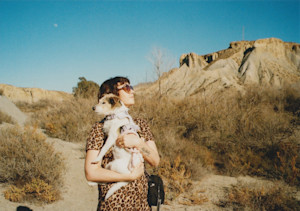
Marianne Eloise
Marianne Eloise’s work has appeared in The New York Times, The Guardian, The Cut, Vulture, and more. She is also the author of an essay collection Obsessive, Intrusive, Magical Thinkingopens in new tab. She has been going on adventures with her dog Bowie since she was 17.
Related articles
![a dog held on a leash sits calmly]()
Dogs Who Are Easy to Train: Top 10 Easiest Dogs to Train
Spoiler: It’s not about the breed. But these pups are pretty brainy.
![A dog running with a woman on a pier.]()
8 Questions to Ask Yourself When Choosing a Dog Breed
Find out which dog breed is right for your lifestyle.
![woman and corgi dog walking through snow]()
Does Your Pup Have Snow-Hound Potential?
Making tracks is another way to enjoy a snowy day with your pup.
![A couple bundled up for winter standing outside in the snow with their dog.]()
Can Dogs Get Frostbite?
Yep, all those warnings your mom gave you as a kid apply to your dog, too. Learn how to keep your pup safe in the cold.
![Two huskies talking to each other outside in the grass.]()
Why Do Huskies Love to ‘Argue’ With Each Other (and Their Humans)?
Find out what all those “roo-roo-rooos” are really about.
![Two cocker spaniel dogs sitting on the garden sofa with a senior woman.]()
Best Dogs for Seniors: What Characteristics Match Your Lifestyle?
The right rescue pup is out there.
